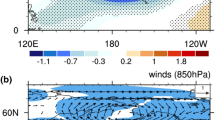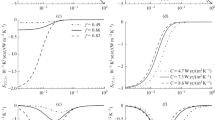Abstract
The current climate change is characterized by both long-term trends caused mainly by human activities and periodic and aperiodic variability caused by natural factors, which are not completely understood. Understanding the processes, that control climate change and variability, is essential from both theoretical and practical points of view. This paper aims at studying the effect of uncertainties in radiative feedbacks and climate system inertia on power spectrum of the global mean surface temperature (GMST) fluctuations. Randomly forced two-box energy balance model (EBM) is used as a main tool of this study. Sensitivity analysis is applied to determine how uncertainties in feedback and climate system inertia affect the power spectrum using the EBM. It was shown that in the high-frequency range of the power spectrum of GMST fluctuations, the influence of climate system inertia is more significant than the influence of feedbacks. In the low-frequency range, on the contrary, the influence of feedbacks on power spectrum exceeds the influence of climate inertia. Our confidence in the results obtained is based on the satisfactory agreement between the theoretical power spectrum derived from the EBM and the power spectrum obtained from observations and coupled climate models, including historical runs of the CMIP5 models.





Similar content being viewed by others
REFERENCES
R. Bradley, Paleoclimatology: Reconstructing Climates of the Quaternary (Elsevier, Oxford, 2015).
IPCC 2013: Climate Change 2013: The Physical Science Basis. Contribution of Working Group I to the Fifth Assessment Report of the Intergovernmental Panel on Climate Change, Ed. by T. F. Stocker, D. Qin, G.-K. Plattner, M. Tignor, S. K. Allen, J. Boschung, A. Nauels, Y. Xia, V. Bex, and P. M. Midgley (Cambridge Univ. Press, New York, 2013).
B. Kirtman, S. B. Power, J. A. Adedoyin, et al., “Near-term climate change: Projections and predictability,” in Climate Change 2013: The Physical Science Basis. Contribution of Working Group I To the Fifth Assessment Report of the Intergovernmental Panel on Climate Change, Ed. by T. F. Stocker, D. Qin, G.-K. Plattner, M. Tignor, S. K. Allen, J. Boschung, A. Nauels, Y. Xia, V. Bex, and P. M. Midgley (Cambridge Univ. Press, New York, 2013), pp. 953–1028.
IPCC, 2014: Climate Change 2014: Synthesis Report. Contribution of Working Groups I, II and III to the Fifth Assessment Report of the Intergovernmental Panel on Climate Change, Ed. by R. K. Pachauri and L. A. Meyer (Geneva, Switzerland, IPCC, 2014).
M. Collins, R. Knutti, J. Arblaster, et al., “Long-term climate change: projections, commitments and irreversibility,” in Climate Change 2013: The Physical Science Basis. Contribution of Working Group I To the Fifth Assessment Report of the Intergovernmental Panel on Climate Change, Ed. by T. F. Stocker, D. Qin, G.-K. Plattner, M. Tignor, S. K. Allen, J. Boschung, A. Nauels, Y. Xia, V. Bex, and P. M. Midgley (Cambridge Univ. Press, New York, 2013), pp. 1029–1136.
G. A. Meehl, T. F. Stocker, W. D. Collins, et al., “Global climate projections,” in Climate Change 2007: The Physical Science Basis. Contribution of Working Group I to the Fourth Assessment Report of the Intergovernmental Panel on Climate Change, Ed. by S. Solomon, D. Qin, M. Manning, Z. Chen, M. Marquis, K. B. Averyt, M. Tignor, and H. L. Miller (Cambridge Univ. Press, Cambridge, 2007), pp. 747–845.
G. Flato, J. Marotzke, B. Abiodun, et al., “Evaluation of climate models,” in Climate Change 2013: The Physical Science Basis. Contribution of Working Group I To the Fifth Assessment Report of the Intergovernmental Panel on Climate Change, Ed. by T. F. Stocker, D. Qin, G.‑K. Plattner, M. Tignor, S. K. Allen, J. Boschung, A. Nauels, Y. Xia, V. Bex, and P. M. Midgley (Cambridge Univ. Press, New York, 2013), pp. 741–866.
R. A. Colman and S. B. Power, “What can decadal variability tell us about climate feedbacks and sensitivity?,” Clim. Dyn. 51, 3815–3828 (2018).
S. Soldatenko and R. Colman, “Climate variability from annual to multi-decadal timescales in a two-layer stochastic energy balance model: Analytic solutions and implications for general circulation models,” Tellus A: Dyn. Meteorol. Oceanogr. 71, 1554421 (2019).
R. Colman and S. Soldatenko, “Understanding the links between climate feedbacks, variability and change using a two-layer energy balance model,” Clim. Dyn. 54, 3441–3459 (2020).
S. A. Soldatenko and R. M. Yusupov, “Estimating the influence of thermal inertia and feedbacks in the atmosphere-ocean system on the variability of the global surface air temperature,” Izv., Atmos. Ocean. Phys. 55 (6), 591–601 (2019).
J. M. Gregory, “Vertical heat transport in the ocean and their effect on time-dependent climate change,” Clim. Dyn. 16, 501–515 (2000).
O. Geoffroy, D. Saint-Martin, D. J. L. Olivie, A. Voldoire, G. Bellon, and S. Tytéca, “Transient climate response in a two-layer energy-balance model. Part I: Analytical solution and parameter calibration using representation of the efficacy of deep-ocean heat uptake and validation for CMIP5 AOGCMs,” J. Clim. 26, 1841–1857 (2013).
V. I. Klyatskin, Lectures on Dynamics of Stochastic Systems (Elsevier, Amsterdam, 2010).
C. Gardiner, Stochastic Methods: A Handbook for the Natural and Social Sciences (Springer, Berlin, 2009).
S. A. Soldatenko and D. Chichkine, “Climate model sensitivity with respect to parameters and external forcing,” in Topics in Climate Modelling, Ed. by T. Hromadka and P. Rao (InTech Publ., Rijeka, Croatia, 2016), pp. 105–135.
G. Roe, “Feedbacks, timescales, and seeing red,” Annu. Rev. Earth Planet. Sci. 37, 93–115 (2009).
C. E. Leith, “The standard error of time-average estimates of climate means,” J. Appl. Meteorol. 12, 1066–1069 (1973).
P. F. Demchenko and V. A. Semenov, “Estimation of uncertainty in surface air temperature climatic trends related to the internal dynamics of the atmosphere,” Dokl. Earth Sci. 476 (1), 1105–1108 (2017).
J. D. Pelletier, “The power spectral density of atmospheric temperature from time scales of 10–2 to 106 yr,” Earth Planet. Sci. Lett. 158, 157–164 (1998).
F. Zhu, J. Emile-Geay, N. P. McKay, G. J. Hakim, D. Khider, T. R. Ault, E. J. Steig, S. Dee, and J. W. Kirchner, “Climate models can correctly simulate the continuum of global-average temperature variability,” Proc. Natl. Acad. Sci. USA 116, 8728–8733 (2019).
M. Rypdal and K. Rypdal, “Long-memory effects in linear response models of Earth’s temperature and implications for future global warming,” J. Clim 27, 5240–5258 (2014).
H. Fredriksen and K. Rypdal, “Spectral characteristics of instrumental and climate model surface temperatures,” J. Clim 29, 1253–1268 (2016).
S. Bony, R. Colman, V. M. Kattsov, R. P. Allan, C. S. Bretherton, J. L. Dufresne, A. Hall, S. Hallegatte, M. M. Holland, W. Ingram, and D. A. Randall, “How well do we understand and evaluate climate change feedback processes?,” J. Clim 19, 3445–3482 (2006).
Author information
Authors and Affiliations
Corresponding authors
Rights and permissions
About this article
Cite this article
Soldatenko, S., Colman, R. Effects of Climate System Feedbacks and Inertia on Surface Temperature Power Spectrum Obtained from CMIP5 and Low-Order Models. Izv. Atmos. Ocean. Phys. 57, 659–668 (2021). https://doi.org/10.1134/S0001433821200044
Received:
Revised:
Accepted:
Published:
Issue Date:
DOI: https://doi.org/10.1134/S0001433821200044




